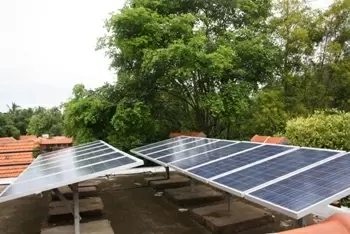In a new route to harness solar energy, scientists hit the highways

05-April-2013
Vol 4 | Issue 14
India's major roads may double up as solar highways, if an innovative proposal by some scientists gets the government's approval. The proposal is the brainchild of scientists at the Gujarat Energy Research and Management Institute (GERMI) in the state capital.
In a paper just published in the International Journal of Energy, Environment and Engineering, the scientists say highways can be used to generate solar power, if a roof of solar panels was laid over them, across the length of the roads.
 |
|
Solar panels can be installed over 52,584 km of national and state highways, say scientists (Photo - for representation purpose only - Courtesy: SELCO India)
|
The photovoltaic (PV) panels that convert sunlight into electricity is normally spread out on land.
"While the price of PV panels is falling day by day, the price of land and its availability are constraints in the development of solar power, especially in India," says Tirumalachetty Harinarayana, director of GERMI and one of the authors of the paper.
"Our proposal overcomes this obstacle by using the space over the highways for placing the PV panels," says Harinarayana. "This space can contribute to energy generation without extra land costs."
The proposal by Harinarayana and co-worker Pragya Sharma is based on case studies they carried out on two highways passing through Gujarat, using computer simulation.
From their computations, they estimate that a PV roof cover over the four-lane 205 km-long Ahmedabad-Rajkot highway can generate 104 MW of power while the Ahmedabad-Vadodara national highway, 93 km long, can generate 61 MW of electricity.
"We can suggest that the same concept can be extended for use on the 52,584-kilometre long national and state highways in India with four lanes or more," the scientists said.
The four-lane 5,839-km long Golden Quadrilateral Highway, for example, connecting Delhi, Mumbai, Chennai and Kolkata, can potentially generate 4,418 MW of power while the North-South-East-West Corridor highway of 7,300 km connecting Srinagar, Kanyakumari, Porbandar and Silchar has 5,524 MW capacity of power generation.
"If having solar panel roof over the national highways proves successful, one can think of using all our rail network as well for solar energy generation," Harinarayana said.
The GERMI scientists claim that apart from producing power, the solar highway concept, if implemented, can generate jobs for both skilled and unskilled people.
"Additionally, the shade provided by the over-head solar panels would result in improved vehicle efficiency and longer tyre life, besides reduction in road maintenance costs," Harinarayana said.
"Another benefit of having a roof over the highways is rainwater harvesting at selected locations," he said.
The scientists point out that the Jawaharlal Nehru Solar Mission (JNSM) launched by Prime Minister Manmohan Singh in Jan 2010 could not reach its target of 1,200 MW electricity by March 2013 due to various problems.
"Again, there is no roadmap or clear plan to reach its 20 GW target by 2022," said Harinarayana. He said the solar highway concept has the potential for large-scale generation of electricity with grid connectivity in short time.
"This requires one-time investment for constructing a simple elevated structure covering the national highways," he said.
According to Harinarayana, Gujarat state is ideally suited to take a lead in implementing the proposal.
The state, he said, has already made great strides in harnessing sunlight by establishing a large solar park near Charanka in the Kutch region, launching the five-MW solar roof top programme in Gandhinagar, and also erection of solar panels on a water canal.
He said GERMI would be ready to demonstrate the feasibility of the solar highway through a 1-MW pilot scale project once the government gives approval. - IANS
















